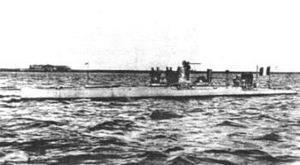French submarine Narval (Q4)

French submarine Narval in 1900
|
|
| History | |
|---|---|
|
|
|
| Name: | Narval |
| Namesake: | The Narwhal |
| Ordered: | 1 June 1898 |
| Builder: | Arsenal de Cherbourg |
| Laid down: | 23 November 1898 |
| Launched: | 21 October 1899 |
| Commissioned: | 26 June 1900 |
| Fate: | Sold for scrap 2 June1920 |
| General characteristics (as built) | |
| Class and type: | unique vessel |
| Displacement: |
|
| Length: | 34 m (111 ft 7 in) (o/a) |
| Beam: | 3.80 m (12 ft 6 in) |
| Draft: | 1.86 m (6 ft 1 in) |
| Installed power: |
|
| Propulsion: |
|
| Speed: |
|
| Range: |
|
| Complement: | 2 officers and 12 crewmen |
| Armament: |
|
French submarine Narval (“Narwhal”) was a pioneering vessel of the French Navy, designed by Maxime Laubeuf and built at the end of the 19th century. She was designed in response to a competition set by the French Admiralty and had several revolutionary features which set the pattern for submarines for the next 50 years.
During the 19th century the French navy was a pioneer in submarine design. From the first practical submarine, Nautilus, in 1800, and the first mechanically powered submarine, Plongeur, in 1863, France had shown a keen interest in submarines as a way of off-setting the naval superiority of her nearest neighbor, Britain.
In 1886 France had built Gymnote, the first electrically powered submarine, solving the problem of a reliable underwater propulsion system. This was followed with Sirene, an enlarged version of Gymnote (and renamed Gustave Zede in 1891 honour of her designer), and Morse, with an experimental bronze alloy hull.
All these and all submarines of the time suffered from two major drawbacks; the optimum features for operating underwater were disadvantages on the surface. The rounded pressure hull, designed to best resist water pressure while submerged, was unhandy on the surface and the early submarines were indifferent sailers. The electric propulsion, safe and efficient underwater, gave limited range and speed on the surface, restricting the submarine to operations near the coast. It was these two disadvantages Laubeuf sought to overcome.
In 1896 the French Admiralty announced an open competition for a new design, specifying a vessel not larger than 200 tons, with a surface range of 100 nautical miles and a speed of 12 knots, with a submerged range of 10 nautical miles and a speed of 8 knots. It received 19 designs, of which Laubeuf's Narval won hands down.
To address the problem of the pressure hull's handling on the surface, Laubeuf used a double-hull design, enclosing the rounded pressure hull (containing the crew and machinery) in a more boat-shaped outer hull, which was unpressurized, the space between given over to those features such as the ballast tanks, fuel tanks, which did not require pressurizing, or simply left open to the water when submerged. This gave a better hydrodynamic shape and led to improved handling on the surface.
...
Wikipedia
